Larimar is a beautiful blue semi-precious stone mined in the Dominican Republic. The blue colors are like ocean colors in the Caribbean and the stone is popular on many islands in the area. On a trip to the Virgin Islands I picked up a specimen of larimar cut like a small marble and a card indicating what stones came from each part of the world.
Here I tried mixing various blues and stirring the colors with a metal rod to create a marbled effect. These beads do not have the usual clear coat of glass called encasing, so the color is right at the surface of the bead. It was an interesting challenge to try to match the color. First I made a core bead and then layered more colors on the surface and stirred those together by hand, being careful to just heat the outside of the bead and not get the entire bead molten.
Stir it up! Click on the photo for an enlarged view.
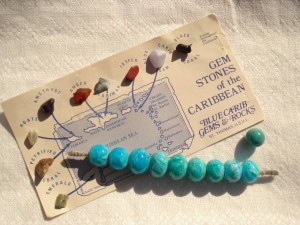
larimar marble and beads
Tags: AuraSunArts, beads, blue, Caribbean, encasing, glass, handmade, larimar, marble, molten, stir, water
 AuraSunArts | mary |
AuraSunArts | mary |  October 20, 2012 7:18 pm |
October 20, 2012 7:18 pm |  Comments (0)
Comments (0)
How does one make a lampworked glass bead?
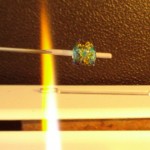
half made bead
Take a steel rod of 2 – 3 mm diameter, coated with a clay release agent, and heat up this rod in the flame. With the other hand, select a glass rod of the color needed, and introduce this slowly to the flame as well. The end of the glass rod will begin to melt, and form a blob, or “gather.” Drip this onto the rod, and wrap it around. Click on the photo for a larger view.
I usually marver the bead now, by rolling it on a flat surface until it takes a cylinder shape, and use this as my canvas to paint with more colors. I keep adding layers of color, and often finish the bead with some clear glass encasing.
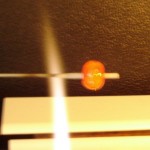
fully molten bead
The bead can be rather lumpy at this point, like a raspberry. I heat it up further until it is entirely molten, and takes on a smooth rounded shape. You must continually rotate the rod to keep the bead centered. If you wish the bead to be textured you skip this rounding. The bead can also be shaped by rolling it on a flat surface, or pressing it into a mold.
Then let it cool down until the normal colors return to the glass, and put it away in a kiln or warming thermal blanket to rest for several hours. The next day it can be taken off the rod: after a soak the clay rinses away and it twists free, the bead is complete and the rod can be re-coated with clay for the next dance.
The flame is a Minor lampworking torch with a mixture of propane and oxygen fuel. Proper ventilation and didymium safety glasses are essential. Wikipedia has several good entries relating to beadmaking and glass art.
Click on any photo here for a larger view.
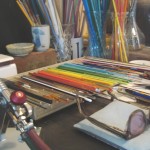
torch, glass rods, and safety glasses
Tags: beads, clay, color, didymium, encasing, glass, handmade, lampwork, marver, molten, thermal, torch
 AuraSunArts, making glass beads | mary |
AuraSunArts, making glass beads | mary |  July 18, 2010 3:09 pm |
July 18, 2010 3:09 pm |  Comments (0)
Comments (0)
Creating small sculptures in glass is an interesting challenge.
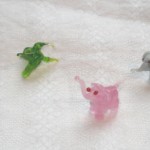
elephants and friends, click to see all
The molten glass is like taffy or honey and tends to leave strings of itself behind. You melt an initial blob to be the body, then dab on another blob at the hip, and watching carefully, pull slowly, drawing out a string of the proper thickness to form a leg, bending it into a leg shape, and then melt the excess away at the foot. Later as you are working on another leg, you must take care to not accidentally melt the first leg, or melt off the tail. It is wise to work on the biggest body parts first and leave the tiny extremities for the last.
Here are some of my baby steps in this arena; a black horse, a green hummingbird, and a trio of elephants. These are not for sale, they are just kindergarten doodles.
To see the work of master glass sculptor Pino Signoretto, and learn about his life, check out this in depth interview at the Nautica website.
“Furthermore, glass itself has something to do with the sea, in effect, to make the magic happen you need four ingredients: sand, water, air and fire, to which I would add a fifth element which is the physical energy which the artist needs to use to shape glass.” ~ Pino Signoretto
Tags: air, animal, element, fire, glass, molten, sand, sculpture, sea, water
 making glass beads, private reserve | mary |
making glass beads, private reserve | mary |  June 20, 2010 5:10 am |
June 20, 2010 5:10 am |  Comments (0)
Comments (0)
Having some copper wire on hand,
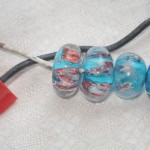
chunks of copper wire encased in glass
I thought to try incorporating some small chunks into some beads. Now if you are trying to melt copper, it is a cranky metal, and will just throw sparks as you pour on the heat with the torch, until it finally surrenders. It holds heat and conducts it, but doesn’t like to melt.
I expected the bits of copper wire to stick readily to the molten glass, but it was having none of it, only left a dent in the soft mass. Well, I flipped the bead dent side up and placed the chip of copper in the cavity with pliers and then sealed it in with clear glass encasing. Great fun! The bright copper looked fine against the turquoise glass. Turquoise and copper are mined together, a natural pair.
The molten glass behaved differently with the copper heat sink it contained, and I tried to let them cool extra slowly, but they still cracked. A grand experiment, nonetheless. Further trials with thinner gauge wire await. Click on the photo for an enlarged view.
People are sometimes puzzled when they see my jewelry.

glass rods
You made the necklace, and the beads? The bead stringing they can understand, but they are sometimes shocked to hear that I made the beads themselves and ask how.
It all starts with glass rods and a torch. Here you see my work area with the many colors of glass rods arrayed on a hotplate. The red knob at lower left is part of the torch. At lower right you see the didymium safety glasses. Click on the photo to see a larger view.
Lampwork is the term used to describe working with molten glass using a small ‘lamp’ or torch. The beads are made by heating up the glass rods until liquid, and wrapping it around a steel rod coated with a release agent. After the bead is complete, the rod is removed and that leaves a hole in the bead.
Stay tuned for weekly posts about beadmaking, other artistic adventures, and the Friday Mo report!






